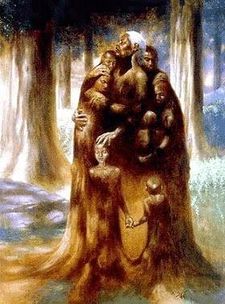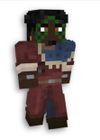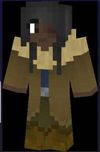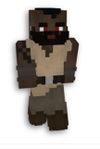Difference between revisions of "The Southeron"
Brotherbot (talk | contribs) m (uwu'ification) |
m (Reverted edits by Brotherbot (talk) to last revision by Brotherbotany) |
||
| Line 8: | Line 8: | ||
|government = Varies | |government = Varies | ||
}} | }} | ||
| − | The | + | The Southeron people, also known as the Southernos or the Southerners - are inarguably the darkest-skinned of the human subraces. Natives to Aegis, the Southerons are known as one of the descendants of the ancient Harrenite tribe; alongside the Adunians. Although its a common stereotype to believe they are aggressive, Southeron are quite calm and care-free(although combative). Many of their chief values include but are not limited to : independence, isolationism, unity, family, honour, tradition, and filial piety. Though they are typically associated with tribalism, some Southeron have opted to live in Feudal societies; forming great families or houses. |
__TOC__ | __TOC__ | ||
| Line 15: | Line 15: | ||
[[File:Juumane.jpeg|100px]] [[File:SouthronGirl.jpg|100px]][[File:Kimani.jpeg|100px]] | [[File:Juumane.jpeg|100px]] [[File:SouthronGirl.jpg|100px]][[File:Kimani.jpeg|100px]] | ||
| − | + | Clothing, as is true of Southeron people as a whole, is widely Diverse. Each tribe has their own specific cultural garbs and customs. They can range from the Khonma Tribe who are known for their unusually light and sparse clothing, typically consisting of little more than an apron or loincloth, to the Mengesha known for their long white shawl like robes called a “Shamma”. If anything is to be said of the commonality in Southeron dress, it is the use of beads, shells, feathers and pelts as decorations and symbols of wealth and status. Use of color also tend to be common amongst many Southeron groups as well. The Southeron are well known for their dark black skin. This is a commonality shared broadly among the disparate groups, besides those of mixed heritage, where there may be more variance. besides that, there is a wide range of physicality as is the case with any of the human races. The hair of a Southeron ranges from tight coils to free-flowing curls - it isn’t uncommon to have more than a single hair type. Though their hair is typically always black in color unless the persons is of mixed heritage or has dyed. Some Southeron, especially those who live in feudal societies, see jewelry as a sign of wealth or a prestigious rank - other Southeron who live without the need for international currency see them as worthless as rocks. Many tribalistic Southerons, similar to the feudal jewelry, see face paint or masks as a sign of prestigious rank - usually sporting the colors of their tribe through them. They are usually the taller of the Farfolk races and boast more exaggerated bodily and facial features. | |
=== Aging === | === Aging === | ||
| − | + | Similar to most Humans, Southerons can live until about 150 years of age - maturing at the age of 18. Their aging methods and appearance depends mainly on genetics, quality of life, and area of living; although they do tend to age more gracefully than their Highlandic and Heartlandic cousins. | |
=== Curses === | === Curses === | ||
| − | See: | + | See: Curse of the [[Humans]]. |
| − | + | Similar to their Human brethren, the Southeron people are victims of the mortality curse casted upon Horen by Iblees. | |
== Culture == | == Culture == | ||
| − | The | + | The culture of the Southeron are varied and unique, consisting of a mixture of various tribes that each have their own unique characteristics. Southeron culture is expressed in its art, folklore and religion, clothing, cuisine, music and language. Though Southeron cultures are host to a wealth of diverse subgroups, it is also, when closely studied, seen to have many similarities. For example, the morals they uphold, their love and respect for their culture as well as the strong respect they hold for their elders and their importants (Kings and Chiefs). Traditional Southeron music is as diverse as the various populations. The common perception of Southeron music is that it is rhythmic music centered on the drums.Although the drum does play a central role in many Southeron musical traditions, that is not fully the case. Other important musical traditions also involve strings, horns and very little rhythm. For example, an important instrument to the Mengesha Tribe is the Kora, a twenty-one-stringed guitar-like instrument made out of a halved, dried, hollowed-out gourd covered with cow or goat skin. The strings are made of fishing line. It plays an important role not only in Mengeshan musical tradition, but also folklore and the Mengesha’s rich oral tradition, as the primary tool of Mengeshan griots. Although most Southerons are known to live sedentary in the desert, they prefer tropical environments that boasts water sources such as: desert oasis’, jungles, desert coasts, lakesides, riversides, etc... - the sun is their friend. Due to previous Southeron interactions with general foreign influence(trade, diplomacy, etc...) - it is arguable to say that there are many languages that Southeron’s speak, the most common of them being [[Ghanwua]], the Common Tongue, and Qalashi. This does not mean that many Southeron are not weary of foreigners – most can easily feel intimidated around groups of people who are unlike them and become more competitive if an event warrants competition. |
==== Language ==== | ==== Language ==== | ||
| Line 32: | Line 32: | ||
=== Tradition === | === Tradition === | ||
| − | In | + | In Southeron societies, tradition is a large and important part of the Southeron culture. Filial piety to one's elders and ancestors especially, are one of the most important aspects of Southeron social relations. Social behaviors such as the respect for parents and elders, raising children appropriately, providing hospitality, and being honest, trustworthy, and courageous are highly valued and even revered as virtues one should live by. This plays into traditional religious thought, as morality is associated with obedience or disobedience to Deities regarding the way a person or a community lives. Most traditional Southeron societies worship various spirits as well as veneration of their ancestors. These spirits are believed to serve as intermediaries between humans and deities. Rituals honoring deities and spirits through libation and sacrifice are common across a number of Southeron cultures. A common form of southeron spiritual tradition is through communal ceremonies or divinatory rites in which members of the community, overcome by force, or spirit, are excited to the point of going into a meditative trance in response to rhythmic or mantric drumming or singing. Divination is a common facet of Southeron culture and Diviners are sought out on a regular basis for wisdom as counselors in life and for their knowledge of herbal medicine. |
== History == | == History == | ||
| − | It is | + | It is commonly believed that when the world began all Humans appeared largely the same, based off of the image of their father, Horen. Due to Human restlessness, drive for discovery and quickly growing population, various groups split off from the first Human settlements. Some lived in the hot, tropical, and flat plains in the area of what would become Whisper Isles and Al'Khazar. They would be the first Southerons. Living in an excellent climate for farming and the growing of crops meant that Southeron grew to become a people well suited for agriculture. In time they grew taller as a result of excellent nutrition, darker skinned with exposure to the sun, growing harsher physical attributes due to their environment, and built up large cities. |
| − | The | + | The Southeron were once seen as a subrace exclusive from their Farfolk brethren. However, when the change of continents began to arrive - the Southeron began to falter as a people; it seemed as though every time there was a Great Descendant Migration - the population of Southeron people would decrease less and less in size. The first migration being arguably the worse, as the geography and environment of the continent was reversed fatally. This caused obstruction - to many of the Southeron, who mainly stayed in one place for the duration of their lives, the geography reverse of the continent caused them to either adjust for survivability or to accept death. Many of the Southeron people failed to adjust, the few remaining being forced to migrate to live with their Northeron cousins for survivability; slowly assimilating into Northeron society, sometimes mating and procreating with them until sovereign Southeron communities were nearly impossible to find after Asulon. As Great Migrations became more frequent, the Southeron community’s population began to decrease. By Athera the Southeron communities had largely died off - though you did find independent Southeron occasionally. |
| − | The | + | The remaining Southeron that adapted to Northeron society had adopted feudalism and joined various Houses, eventually forming great families of their own in the nations they were with. Places such as The Sultanate of Haria and Empire of Oren had at least one demographic group with Southeron ancestry or heritage. The Southeron people were slowly making a return come Axios, adapting to Feudalism fairly well. It was not until Atlas that many of the surviving remnants of the Southeron people, displaced on the new continent, found themselves divided and separated into disparate tribes adopting their own personal traditions. |
| − | To avoid | + | To avoid risking the reduction of their populations once more, many Southeron societies and Elders advise against intermingling with foreigners, some even making it a crime. |
=== Notable Figures === | === Notable Figures === | ||
| − | [[Azulo]] - the Chieftain of the | + | [[Azulo]] - the Chieftain of the Sahiri, Progenitors of the Southeron People |
| − | + | Forrest Sarr - A notable pirate and Steward of Privets | |
| − | + | Ford Vallero(The Ear-Slicer) - A notable killer and member of the White Rose who typically targeted Elves, ironically settling down with an Adunian. | |
| − | Juumane M’Baku - | + | Juumane M’Baku - First Neguš of Ghanyah and one of the first Southeron persons to lead on a national level. |
| − | Haadi Mubdee - A | + | Haadi Mubdee - A powerful mage and an Archmage/Founder of the Mages Guild or The Tamed Arcane |
| − | [[Kalfu]]- | + | [[Kalfu]]- First Leader of the Rasdom of Melle, previous Advisor of Ghanyah and one of the first and most powerful Southeron leaders on a national level. |
| − | [[Matthias Rutledge]] - | + | [[Matthias Rutledge]] - First Southeron to be elected as Prince of [[Ves]] |
=== Nations === | === Nations === | ||
| − | The | + | The Southeron mainly inhabit desert-like environments - making it a point to bunch up around water sources |
==== Current ==== | ==== Current ==== | ||
[[The Medri Negasi of Seyam]] | [[The Medri Negasi of Seyam]] | ||
| Line 74: | Line 74: | ||
*''[[Melle]]'' | *''[[Melle]]'' | ||
| − | *The | + | *The Lost City of Nya'ne |
=== Familial Groups === | === Familial Groups === | ||
| Line 86: | Line 86: | ||
*[[Zailu]]<br> | *[[Zailu]]<br> | ||
*M'Baku<br> | *M'Baku<br> | ||
| − | * | + | *Okarachi<br> |
*Atatis<br> | *Atatis<br> | ||
*Denaseth<br> | *Denaseth<br> | ||
== Random Tidbits == | == Random Tidbits == | ||
| − | * | + | * Although they are a seen by everyone else as a subrace of [[Farfolk]], most Southeron do not like to be bunched into the category and would take great offense to it. |
| − | * | + | * Southeron is both a singular and plural word! |
Revision as of 01:36, 2 April 2020
| ||||||||||||||
The Southeron people, also known as the Southernos or the Southerners - are inarguably the darkest-skinned of the human subraces. Natives to Aegis, the Southerons are known as one of the descendants of the ancient Harrenite tribe; alongside the Adunians. Although its a common stereotype to believe they are aggressive, Southeron are quite calm and care-free(although combative). Many of their chief values include but are not limited to : independence, isolationism, unity, family, honour, tradition, and filial piety. Though they are typically associated with tribalism, some Southeron have opted to live in Feudal societies; forming great families or houses.
Contents
Physicality and Appearances
Clothing, as is true of Southeron people as a whole, is widely Diverse. Each tribe has their own specific cultural garbs and customs. They can range from the Khonma Tribe who are known for their unusually light and sparse clothing, typically consisting of little more than an apron or loincloth, to the Mengesha known for their long white shawl like robes called a “Shamma”. If anything is to be said of the commonality in Southeron dress, it is the use of beads, shells, feathers and pelts as decorations and symbols of wealth and status. Use of color also tend to be common amongst many Southeron groups as well. The Southeron are well known for their dark black skin. This is a commonality shared broadly among the disparate groups, besides those of mixed heritage, where there may be more variance. besides that, there is a wide range of physicality as is the case with any of the human races. The hair of a Southeron ranges from tight coils to free-flowing curls - it isn’t uncommon to have more than a single hair type. Though their hair is typically always black in color unless the persons is of mixed heritage or has dyed. Some Southeron, especially those who live in feudal societies, see jewelry as a sign of wealth or a prestigious rank - other Southeron who live without the need for international currency see them as worthless as rocks. Many tribalistic Southerons, similar to the feudal jewelry, see face paint or masks as a sign of prestigious rank - usually sporting the colors of their tribe through them. They are usually the taller of the Farfolk races and boast more exaggerated bodily and facial features.
Aging
Similar to most Humans, Southerons can live until about 150 years of age - maturing at the age of 18. Their aging methods and appearance depends mainly on genetics, quality of life, and area of living; although they do tend to age more gracefully than their Highlandic and Heartlandic cousins.
Curses
See: Curse of the Humans. Similar to their Human brethren, the Southeron people are victims of the mortality curse casted upon Horen by Iblees.
Culture
The culture of the Southeron are varied and unique, consisting of a mixture of various tribes that each have their own unique characteristics. Southeron culture is expressed in its art, folklore and religion, clothing, cuisine, music and language. Though Southeron cultures are host to a wealth of diverse subgroups, it is also, when closely studied, seen to have many similarities. For example, the morals they uphold, their love and respect for their culture as well as the strong respect they hold for their elders and their importants (Kings and Chiefs). Traditional Southeron music is as diverse as the various populations. The common perception of Southeron music is that it is rhythmic music centered on the drums.Although the drum does play a central role in many Southeron musical traditions, that is not fully the case. Other important musical traditions also involve strings, horns and very little rhythm. For example, an important instrument to the Mengesha Tribe is the Kora, a twenty-one-stringed guitar-like instrument made out of a halved, dried, hollowed-out gourd covered with cow or goat skin. The strings are made of fishing line. It plays an important role not only in Mengeshan musical tradition, but also folklore and the Mengesha’s rich oral tradition, as the primary tool of Mengeshan griots. Although most Southerons are known to live sedentary in the desert, they prefer tropical environments that boasts water sources such as: desert oasis’, jungles, desert coasts, lakesides, riversides, etc... - the sun is their friend. Due to previous Southeron interactions with general foreign influence(trade, diplomacy, etc...) - it is arguable to say that there are many languages that Southeron’s speak, the most common of them being Ghanwua, the Common Tongue, and Qalashi. This does not mean that many Southeron are not weary of foreigners – most can easily feel intimidated around groups of people who are unlike them and become more competitive if an event warrants competition.
Language
See : Ghanwua
Tradition
In Southeron societies, tradition is a large and important part of the Southeron culture. Filial piety to one's elders and ancestors especially, are one of the most important aspects of Southeron social relations. Social behaviors such as the respect for parents and elders, raising children appropriately, providing hospitality, and being honest, trustworthy, and courageous are highly valued and even revered as virtues one should live by. This plays into traditional religious thought, as morality is associated with obedience or disobedience to Deities regarding the way a person or a community lives. Most traditional Southeron societies worship various spirits as well as veneration of their ancestors. These spirits are believed to serve as intermediaries between humans and deities. Rituals honoring deities and spirits through libation and sacrifice are common across a number of Southeron cultures. A common form of southeron spiritual tradition is through communal ceremonies or divinatory rites in which members of the community, overcome by force, or spirit, are excited to the point of going into a meditative trance in response to rhythmic or mantric drumming or singing. Divination is a common facet of Southeron culture and Diviners are sought out on a regular basis for wisdom as counselors in life and for their knowledge of herbal medicine.
History
It is commonly believed that when the world began all Humans appeared largely the same, based off of the image of their father, Horen. Due to Human restlessness, drive for discovery and quickly growing population, various groups split off from the first Human settlements. Some lived in the hot, tropical, and flat plains in the area of what would become Whisper Isles and Al'Khazar. They would be the first Southerons. Living in an excellent climate for farming and the growing of crops meant that Southeron grew to become a people well suited for agriculture. In time they grew taller as a result of excellent nutrition, darker skinned with exposure to the sun, growing harsher physical attributes due to their environment, and built up large cities.
The Southeron were once seen as a subrace exclusive from their Farfolk brethren. However, when the change of continents began to arrive - the Southeron began to falter as a people; it seemed as though every time there was a Great Descendant Migration - the population of Southeron people would decrease less and less in size. The first migration being arguably the worse, as the geography and environment of the continent was reversed fatally. This caused obstruction - to many of the Southeron, who mainly stayed in one place for the duration of their lives, the geography reverse of the continent caused them to either adjust for survivability or to accept death. Many of the Southeron people failed to adjust, the few remaining being forced to migrate to live with their Northeron cousins for survivability; slowly assimilating into Northeron society, sometimes mating and procreating with them until sovereign Southeron communities were nearly impossible to find after Asulon. As Great Migrations became more frequent, the Southeron community’s population began to decrease. By Athera the Southeron communities had largely died off - though you did find independent Southeron occasionally.
The remaining Southeron that adapted to Northeron society had adopted feudalism and joined various Houses, eventually forming great families of their own in the nations they were with. Places such as The Sultanate of Haria and Empire of Oren had at least one demographic group with Southeron ancestry or heritage. The Southeron people were slowly making a return come Axios, adapting to Feudalism fairly well. It was not until Atlas that many of the surviving remnants of the Southeron people, displaced on the new continent, found themselves divided and separated into disparate tribes adopting their own personal traditions.
To avoid risking the reduction of their populations once more, many Southeron societies and Elders advise against intermingling with foreigners, some even making it a crime.
Notable Figures
Azulo - the Chieftain of the Sahiri, Progenitors of the Southeron People
Forrest Sarr - A notable pirate and Steward of Privets
Ford Vallero(The Ear-Slicer) - A notable killer and member of the White Rose who typically targeted Elves, ironically settling down with an Adunian.
Juumane M’Baku - First Neguš of Ghanyah and one of the first Southeron persons to lead on a national level.
Haadi Mubdee - A powerful mage and an Archmage/Founder of the Mages Guild or The Tamed Arcane
Kalfu- First Leader of the Rasdom of Melle, previous Advisor of Ghanyah and one of the first and most powerful Southeron leaders on a national level.
Matthias Rutledge - First Southeron to be elected as Prince of Ves
Nations
The Southeron mainly inhabit desert-like environments - making it a point to bunch up around water sources
Current
Previous
- The Lost City of Nya'ne
Familial Groups
Current
Previous
Random Tidbits
- Although they are a seen by everyone else as a subrace of Farfolk, most Southeron do not like to be bunched into the category and would take great offense to it.
- Southeron is both a singular and plural word!
| |||||||||||||||



